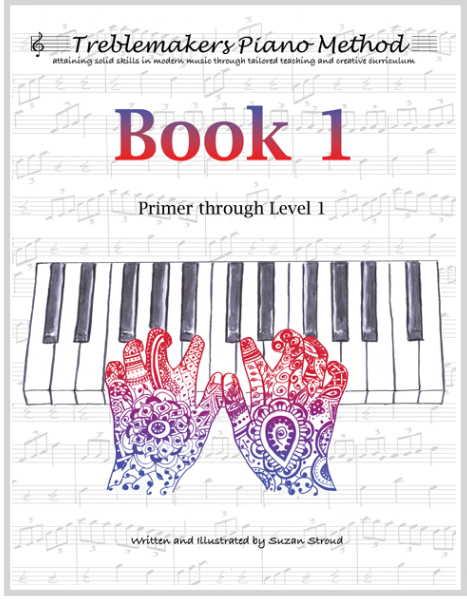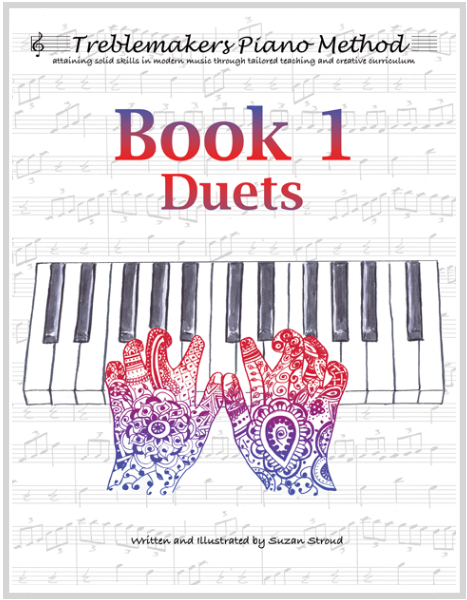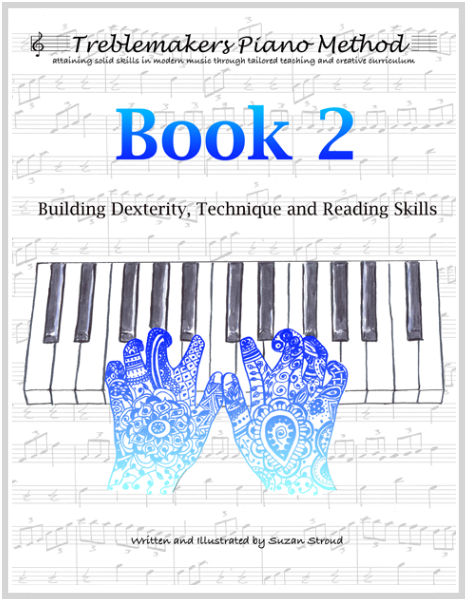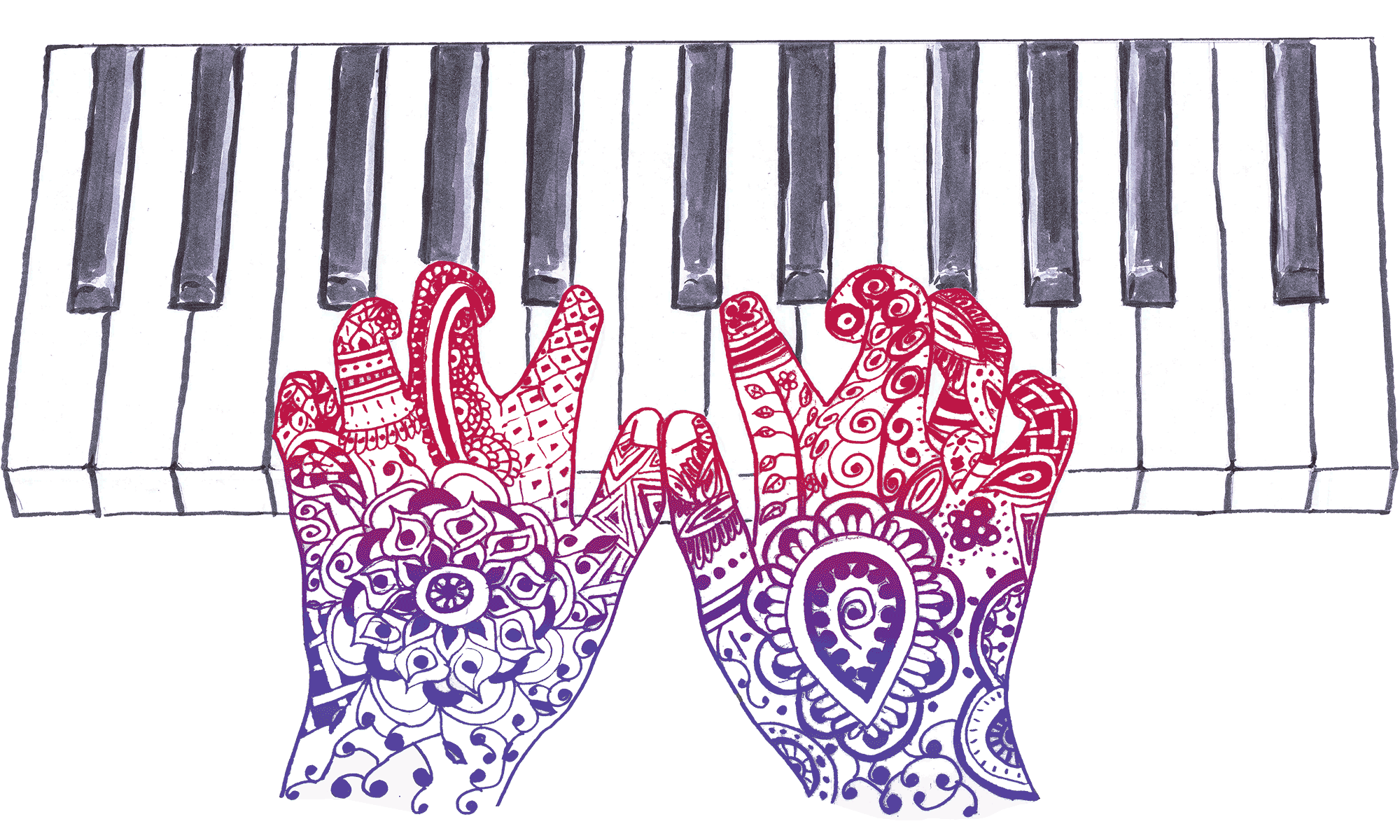What is Different About the Treblemakers Method?
Treblemakers Piano Method builds strong reading skills easily from the very beginning using strategies designed to take advantage of how the brain, memory and learning work. Students struggle to build solid reading skills when too many notes are introduced at once without providing enough material to master them before moving on.
Treblemakers Piano Method introduces small note-groupings then provides material needed to use until mastered. Drill on note ranges using Quizzes and Flash Cards and play songs to use information in action.



Treblemakers Method Books FAQ
The Treblemakers method was designed to build strong reading and playing skills in a musical and fun way. Building a strong foundation from the beginning eases the challenges that come as piano music becomes more difficult.
“A book that starts with nine songs on only C,D,E will be too easy.”
While this may be true for a student’s PLAYING LEVEL, it is not true for their READING LEVEL. Taking a small amount of information and giving it the proper repetition is the best way to master reading quickly. Introducing too many notes at once or moving on too quickly results in a much longer learning process for the same amount of information.
Students should work at two levels. One level that challenges physical playing ability and another that builds a strong reading foundation. Treblemakers Method Books are designed to allow customizable pacing. Students can add outside pieces or songs they are interested in playing, jump ahead to the hands together level one section of Book 1 or learn Book 2 pieces for a playing challenge. Make sure to also continue in order through the book to build strong reading skills.
“I was able to play all the C, D, E songs right away. I should add more notes.”
Students often mistake the ability to use their WORKING MEMORY to do something effectively in the moment as having mastered or learned something. This is temporary memory. In order to be stored in LONG TERM memory it will need to be revisited regularly over a longer period of time. Although, harder pieces can be added for playing enjoyment, keep note-drilling ranges small until mastered before adding new notes.
“How do I know if I’ve mastered information?”
Information is mastered if you can use it easily to do something perfectly the first time you sit down after having not used it for a period of time. From one day to the next is a good first measure. Ultimately, you’ll want to make sure that you can retain it over a month. That doesn’t mean you need to wait a month to add new information, but it does mean you need to continue to regularly use it throughout the month even as you add new material.
“How can a four year old student read music if they can’t read books yet?”
As long as they know the first seven letters of their alphabet, they can read music. Four and five year olds have different challenges in reading than older students though so it’s important is to tackle concepts that impact their understanding in order to be successful. Make sure they can see the difference between lines and spaces and distinct locations on the staff. Relate it to things they can understand: the bottom line of the staff is the closest to the floor, the top line is closest to the ceiling, etc. They often need help seeing that notes that may look differently (be colored in or have a stem) are still middle C as long as they are on the ledger line below the treble clef staff.
“How do I know what the perfect sight reading practice level is?”
A general rule is if it can be played perfectly with notes and rhythms the first time, it’s too easy. If it can’t be perfected within in three tries, it’s too hard.
“I know there are other methods that just focus on memorizing and performing. Can’t students learn reading later?”
When reading isn’t introduced right away, students often struggle to build strong reading skills. The larger the gap between the music a student can play and read is, the more discouraging it can be. Students build the habit of learning by rote only and resist reading because it feels more difficult. Learning by rote is effective for tackling challenges but shouldn’t be the only way a student learns. If reading is introduced right away, it can be built gradually and easily.
“Why is reading important?”
Using memory on the system of reading music is much more effective than only memorizing pieces. It allows musicians to play a much larger amount of music, keeping old repertoire and adding new music easily. Reading music is an important part of being independent and fluent in the language of music.
“I’ve seen people who can play by ear. If you can do that why do you need to learn to read music?”
Playing by ear is a great skill to have but ONLY playing by ear will limit a player to things that they can recognize. Learning to play an instrument combines a lot of different skills which all factor into how well rounded a musician is and what they’re capable of.
“Won’t older students get bored if they move too slow?”
Except for very young students, it’s always a great idea to work at two levels: Reading level, and Playing level. Playing level pieces may be too difficult to read easily but will challenge playing skills. Students can add these pieces alongside reading level pieces. They can jump ahead to the hands together section of Book 1, take a piece from Book 2 or add other music they are interested in. Just remember to also continue in order through the book to build strong reading skills.
How do I know how long to spend on each section?
The books are designed to be customizable so that students can move at their individual pace. Although age suggestions can be made, how fast is ideal to move can vary from student to student.
Young Beginners: (4-7) Spend a week or two on each piece. Learn notes first, then add rhythm and duets for playing in time
Beginners: ( 8-10) Take two or three songs each week.
Teenager or Adult: who can play the C,D,E songs perfectly right away should also jump ahead to the hands together section adding the two left hand chord shapes while continuing through in order with two or three songs as reading assignments for the week. This allows playing at a level that is satisfying while still building strong reading skills.
